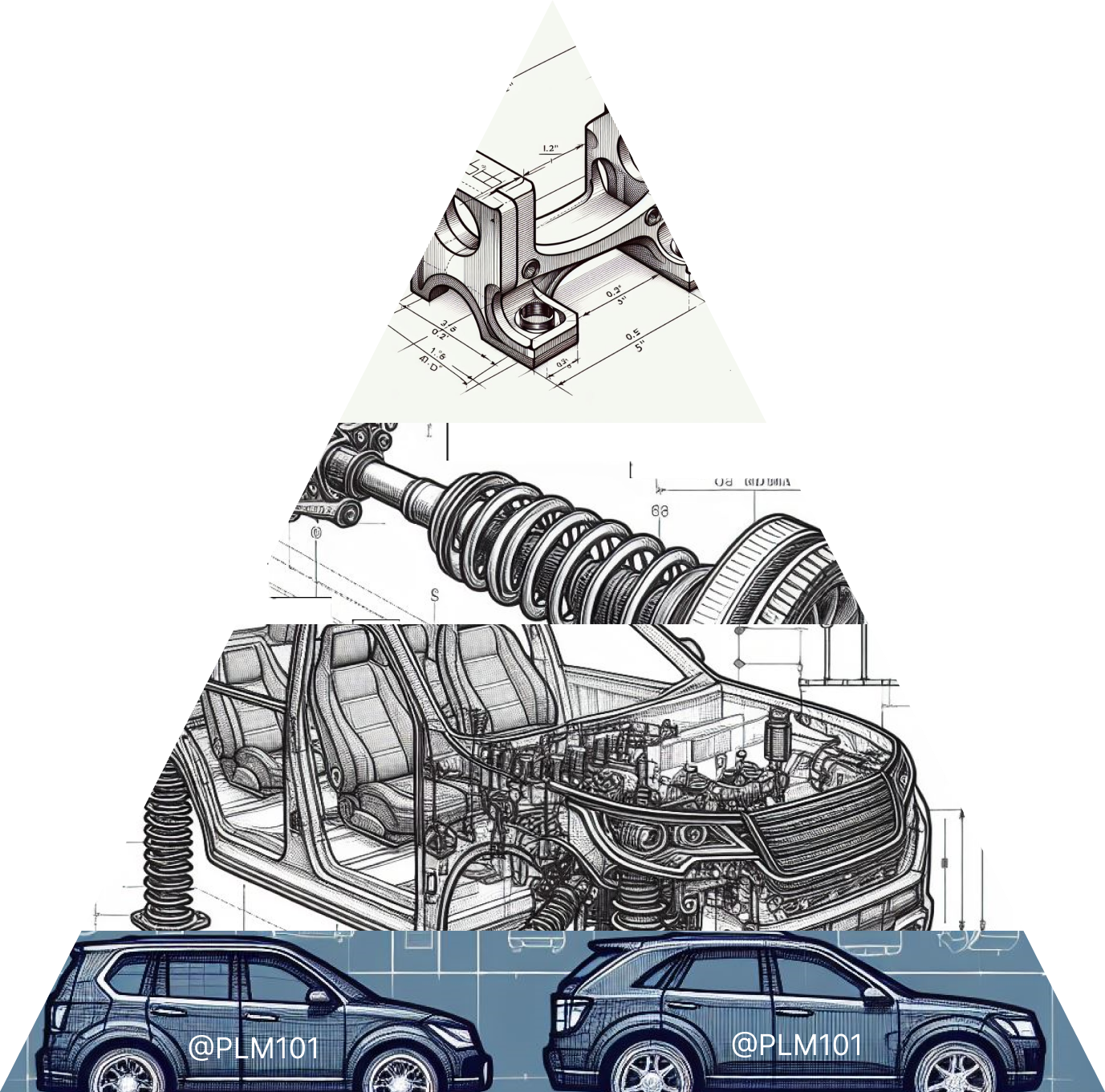PLM manages product data and processes across the entire lifecycle and does it with a remarkable ability. But how does it do it? And why does it work?. This article tries to answer these questions by providing a rough outline of what’s going on inside PLM and explores why it is that it can do so well in supporting product development and management.
Unpacking the core function
Before diving deep, it’s essential to understand Product Lifecycle Management (PLM)’s fundamental mission: managing product data and processes seamlessly across various departments and throughout the entire product lifecycle.
So let’s say we have to design a new product.
We have received the technical requirements and specifications, including must-have and nice-to-have features that will shape the desired form, fit, and function. And the design constraints imposed by manufacturing and operational capabilities. We get to work to create the preliminary concept designs and prototypes. We utilize meticulously crafted templates for documentation – encompassing specs, procedures, and more. We produce 3D models, 2D drawings, BOMs, visualizations. We simulate and generate analysis results like FEA, CFD. ☝️ PLM helps to manage all of these product data.
Now, let’s look into the prototype-to-production approval process.
Our engineering (design engineers, analysis leads, test engineers) develops initial prototypes based on requirements. Prototypes are evaluated under test conditions and with target users, feedback gathered, design refined, updated prototypes produced and tested iteratively. Design reviews held to evaluate maturity.
Our cross-functional teams, including Manufacturing (production engineers, plant managers, technicians), Quality (quality engineers, inspection teams) and Supply Chain (procurement, logistics leads) approve final prototype to move into pilot production.
Manufacturing runs limited pilot production, Quality evaluates first articles internally and with lead customers. Corrective actions taken by all the teams involved, if needed, to resolve issues.
Final production approval secured from project leadership (project managers, VP-level champions) and full ramp-up of production planned and executed. 👆 PLM helps to manage all these processes.
Why managing the product data and processes work?
First, PLM’s centralized capabilities allow managing complexity as designs evolve. Like enabling the design engineers to leverage existing components, technologies and standards and applying lessons learned & insights from previous generations or revisions of the product or related products.
Second, the process balances rigor to ensure requirements are met with pragmatism to deliver to market and customer needs. A prime example is the orchestration of Design Reviews and Validation Testing.
Let us say we’ve a typical Design Review cycle. Preliminary Design Review (PDR) evaluates initial design concept vs. requirements. Critical Design Review (CDR) assesses detailed design and supporting analysis. Production Readiness Review (PRR) verifies design is ready for production. PLM not only manages these critical documents but also seamlessly integrates them into the approval and release processes.
Another illustrative case is the validation of product maturity, starting from the granular component level and culminating in a comprehensive evaluation of the overall system. We often start with component-level validation – e.g. stress testing a bracket. Then advance to subsystem validation – e.g. thermal testing an electronics module, and eventually maturing to system-level validation – e.g. vibration testing integrated design. Ultimately, it culminates in operational testing, where the product undergoes evaluation in real or simulated usage scenarios, affirming its compliance with established requirements. With PLM ensuring each phase of validation aligning harmoniously, the product can confidently launch into full production.
How PLM manages the product lifecycles
Let’s consider a part, like a bracket. Let’s dive deeper into how data elements and their relationships are managed within PLM. This journey will take us from a basic understanding of the bracket’s lifecycle to progressively more complex data maps resembling the lifecycles of more intricate products.
Let’s imagine we’re designing a bracket for an automotive application. Here’s some data elements:
- Bracket Design Metadata:
- Dimensions: 12 inches (length), 3 inches (width), 0.25 inches (thickness).
- Material: High-strength steel alloy.
- Load-bearing capacity: 1000 lbs.
- Surface finish: Powder coating for corrosion resistance.
- Manufacturing Metadata:
- Production process: CNC machining.
- Tooling and fixture designs: CAD files for machining jigs.
- BOM: List of materials, including steel, fasteners, and coatings.
- Quality control criteria: Dimensional tolerance limits.
- Testing and Analysis Metadata:
- FEA results: Bracket can withstand 150% of the specified load.
- Test reports: Successful load tests and user feedback.
- Lifecycle Metadata:
- Revision history: Four revisions to address design improvements.
- Prototyping history: Three iterations with design enhancements.
- Document versions: Latest revisions of CAD files and specifications.
- Key milestones: Prototype approval on 19th Oct 2023, production start on 14th Dec 2023….
Now, let’s progressively connect relationships from our bracket to a broader product context, mimicking the intricate data maps in a PLM system:

Bracket Within a Subsystem: Our bracket is part of an automotive subsystem (e.g., suspension). The subsystem data in PLM references the bracket’s design and specifications.
Subsystem in the Context of the Vehicle: The suspension subsystem integrates with the overall vehicle design. The vehicle data in PLM references to subsystems and their associated brackets.
Vehicle as a Complete Product: The vehicle, in turn, is part of a broader product portfolio. Product data in PLM references to individual vehicles, subsystems, and their respective brackets.
Product Family and Variants: Beyond a single product, a family of vehicles may exist, sharing common components like brackets.
Variants within the product family introduce further complexity, each with its own set of data.
As we progress through these layers of data relationships, we see how PLM manages not just individual components like our bracket but also the intricate web of data that connects them within a product’s lifecycle. From a single part to a complete product family, PLM ensures that data is structured, accessible, and updated throughout the lifecycle!
The Big Idea: PLM as the System of Record
Now that we’ve delved into how PLM enables us to manage the lifecycles of individual components and products, it’s time to address a critical aspect that empowers PLM to handle the complexity of modern manufacturing.
In the manufacturing landscape, there are thousands of possible data entities that span across engineering, manufacturing, service, and various other domains. These entities encompass everything from part designs and production processes to quality standards and service records. This sheer volume of data, coupled with the intricate relationships between these entities, presents a formidable challenge.
So, what can we do to make sense of this data deluge and ensure that it contributes to the success of our product lifecycles? The answer lies in the creation of a comprehensive data model with PLM at its core, serving as the System of Record.
Imagine PLM as the central hub of your manufacturing operations, where all product-related data converges and is meticulously organized. This concept is akin to a control tower at an airport, managing the flow of information and ensuring that every component of the operation is coordinated efficiently.
- Data Consolidation: PLM serves as a unifying platform where all data entities across the product lifecycle converge. This consolidation eliminates data silos, fostering collaboration and ensuring that every stakeholder has access to the most up-to-date information.
- Single Source of Truth: With PLM as the System of Record, there’s no ambiguity about where to find the latest design iteration, production process details, or service BOMs. It establishes a single source of truth, reducing errors, miscommunication, and rework.
- Efficient Decision-Making: Having a central repository of data enhances decision-making across all stages of the product lifecycle. Engineers, manufacturers, and service teams can make informed choices based on real-time information, ultimately leading to improved product quality and reduced time-to-market.
- End-to-End Visibility: PLM’s role as the System of Record provides end-to-end visibility into the product lifecycle. This means that you can track a product from its initial design phase through production, quality assurance, and even into the field for service and maintenance. Such visibility enables proactive problem-solving and continuous improvement.
- Change Management: Managing changes is a fundamental aspect of product development and manufacturing. PLM as the System of Record streamlines change management processes, ensuring that any modifications to design, materials, or processes are well-documented, approved, and implemented seamlessly.
- Regulatory Compliance: In many industries, adherence to regulatory standards is non-negotiable. PLM serves as a valuable tool for documenting compliance efforts, ensuring that every step of the product lifecycle meets the required standards and certifications.
- Scalability and Adaptability: As your product portfolio expands and evolves, PLM can scale and adapt to accommodate new data entities and relationships. This scalability future-proofs your operations, allowing for sustained growth and innovation.
- Data-Driven Insights: By consolidating and analyzing data from various phases of the product lifecycle, PLM transforms raw information into actionable insights. These insights empower organizations to make strategic decisions, optimize processes, and drive continuous improvement.